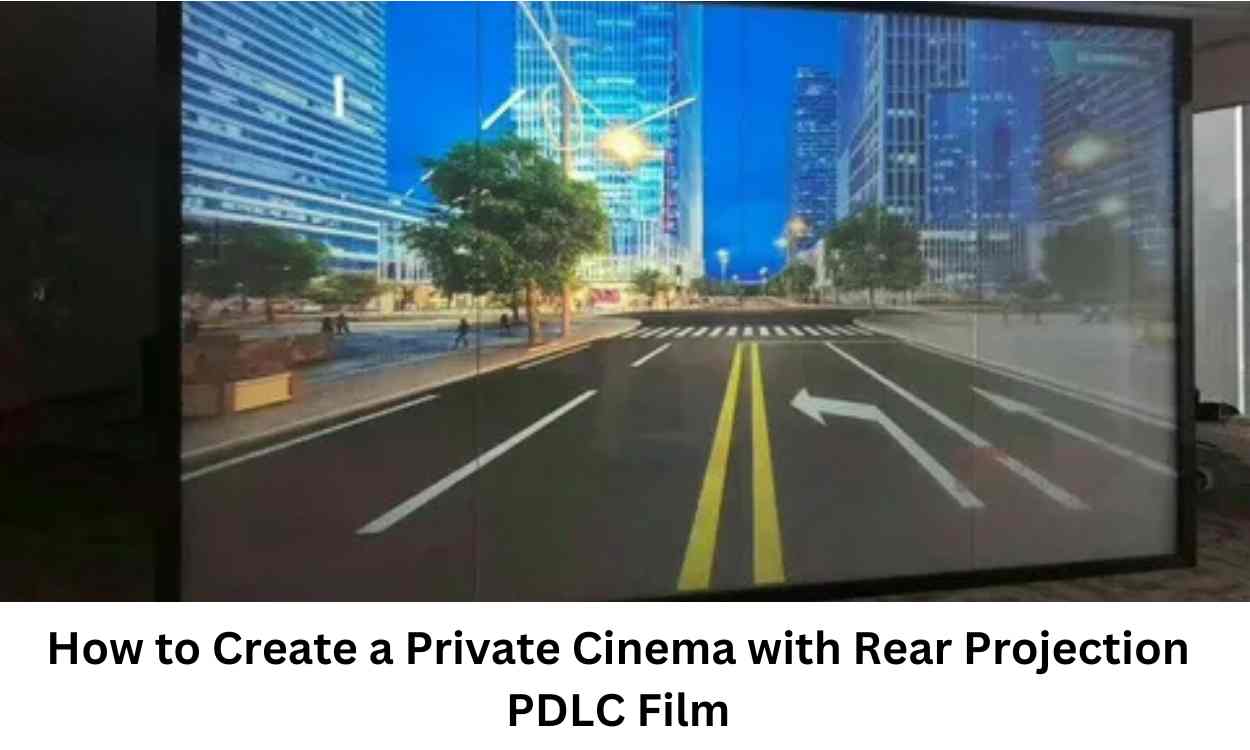Imagine having your own private cinema at home where you can watch your favorite movies and shows in high quality, without the distractions of a public theater. It’s a dream for many film lovers, but with modern technology, it’s easier than ever to bring this dream to life. One of the best ways to do this is by using Rear Projection PDLC Film. This advanced technology lets you create a seamless and high-quality viewing experience right in your home, transforming any space into a private cinema. In this blog, we will guide you through everything you need to know about setting up a private cinema with Rear Projection PDLC Film.
Note : Ready to take your movie nights to the next level? Explore the possibilities of Rear Projection PDLC Film and transform your space into a private cinema. Contact a trusted supplier today and get started on creating a home theater that will amaze your family and friends.
What Is Rear Projection PDLC Film?
Before diving into the setup process, it’s important to understand what Rear Projection PDLC Film is and how it works. PDLC stands for Polymer Dispersed Liquid Crystal. This film can change from transparent to opaque when an electrical current is applied. When used with a projector, the film can act as a projection screen, offering a high-quality image that is viewable from the opposite side. This means you can watch a movie or presentation on a glass surface without needing a bulky screen or dedicated wall.
Rear Projection PDLC Film is often used in homes, offices, and commercial spaces because of its flexibility. It allows you to turn any glass surface into a display screen while still providing privacy when needed.
Why Choose Rear Projection PDLC Film for a Private Cinema?
Creating a private cinema in your home is a big decision, so why should you consider using Rear Projection PDLC Film for this project? Here are some key reasons that make this technology an excellent choice for your home theater:
1. High-Quality Image Display
One of the main advantages of Rear Projection PDLC Film is the high-quality image it produces. The film is designed to offer a clear and bright display, even in rooms with some ambient light. This means you don’t need to be in complete darkness to enjoy your movies, unlike with some traditional projection screens.
When combined with a high-resolution projector, Rear Projection PDLC Film delivers sharp images and vibrant colors, making it perfect for watching movies, sports, and streaming shows. The result is a cinema-like experience without ever having to leave your home.
2. Space-Saving Solution
Unlike traditional home theater setups that require large screens or dedicated walls, Rear Projection PDLC Film can be applied directly to glass surfaces like windows or partitions. This makes it a space-saving solution, especially for smaller rooms where a large screen might not fit. You can transform a living room window or glass door into a projection screen, making it an ideal choice for homes where space is limited.
Additionally, because the film can switch between transparent and opaque states, you don’t have to sacrifice natural light when you’re not using the cinema. The glass surface can remain clear when the projector is off, allowing sunlight to brighten up the room during the day.
3. Versatile Design Options
Another benefit of Rear Projection PDLC Film is its versatility in design. It can be cut and applied to fit windows, doors, or other glass surfaces of various shapes and sizes. This allows you to customize the size of your screen according to your space and preferences. Whether you want a standard-sized screen or a wall-to-wall display, Rear Projection PDLC Film makes it possible.
This flexibility means you can integrate the film into your existing interior design without having to rearrange your entire space. It’s a great option for those who want a private cinema that blends seamlessly into their home environment.
How to Set Up a Private Cinema with Rear Projection PDLC Film
Creating a private cinema with Rear Projection PDLC Film is a straightforward process, but there are a few key steps to ensure you get the best results. Here’s a simple guide to help you set up your own home theater:
1. Choose the Right Location
The first step is to choose the right location for your private cinema. Look for a room or area that has a large glass surface, such as a sliding glass door, window, or glass partition. The space should be relatively free from direct sunlight to prevent glare on the film during use.
Think about where you’ll place your seating, projector, and sound system to create a comfortable viewing experience. If possible, try to choose a space where you can easily control the lighting, like a room with curtains or blinds.
2. Measure the Glass Surface
Once you’ve chosen the location, measure the glass surface where you plan to install the Rear Projection PDLC Film. This will help you determine how much film you’ll need and ensure that it fits properly. Make sure to measure both the height and width accurately.
Most suppliers can provide the film in custom sizes to match your measurements, so don’t worry if your window or glass partition isn’t a standard size. Having the right fit is important to achieve a seamless projection experience.
3. Apply the Rear Projection PDLC Film
Applying the Rear Projection PDLC Film can be done as a DIY project if you’re comfortable working with glass surfaces, or you can hire a professional for the installation. Here are the basic steps if you choose to do it yourself:
- Clean the glass surface thoroughly to remove any dust or fingerprints.
- Cut the Rear Projection PDLC Film to match the size of the glass.
- Peel off the protective backing from the film.
- Carefully apply the film to the glass surface, smoothing out any air bubbles as you go.
- Connect the film to a power source to enable the switching feature.
Make sure to follow the manufacturer’s instructions closely for the best results.
4. Set Up Your Projector
After the film is applied, it’s time to set up the projector. Position the projector behind the Rear Projection PDLC Film, facing the glass surface where you’ll watch the content. Make sure the projector is at the correct distance to fill the entire film with the image.
Choose a high-resolution projector that is compatible with rear projection. Many projectors today come with adjustable focus and keystone correction, allowing you to get a clear and properly aligned image on the film.
5. Connect Your Sound System
For a true cinema experience, don’t forget to add a good sound system. Surround sound speakers or a high-quality soundbar can make a big difference in your viewing experience. Position the speakers around the room to create an immersive audio environment.
Make sure to connect the projector to your streaming device, Blu-ray player, or gaming console, and test everything out before inviting guests over for movie night.
6. Enjoy Your Private Cinema
Once everything is set up, you’re ready to enjoy your new private cinema! Dim the lights, grab your favorite snacks, and settle in for a movie night like no other. You’ll be able to enjoy all the benefits of Rear Projection PDLC Film, including the ability to switch between clear glass and a high-quality screen.
Cost Considerations for a Private Cinema Setup
The cost of creating a private cinema with Rear Projection PDLC Film can vary depending on the size of the film, the type of projector you choose, and whether you hire a professional for installation. Here’s a general breakdown of potential costs:
- Rear Projection PDLC Film: Prices typically range from $100 to $200 per square meter.
- Projector: High-resolution projectors for home theaters can cost between $500 to $2,000.
- Installation: Professional installation may add an additional $200 to $500, depending on the complexity of the job.
- Sound System: A good sound system might range from $200 to $1,000.
While the initial investment might seem high, the result is a high-quality, versatile, and private cinema experience that you can enjoy for years to come.
Conclusion
Setting up a private cinema at home is easier than you might think, especially when using Rear Projection PDLC Film. This innovative film allows you to turn any glass surface into a high-quality screen, providing an immersive viewing experience without the need for bulky equipment. With the right planning and a few key pieces of technology, you can create a stylish and functional home theater that offers the perfect blend of privacy, flexibility, and entertainment.
For more insightful articles related to this topic, feel free to visit unbusinessnews










